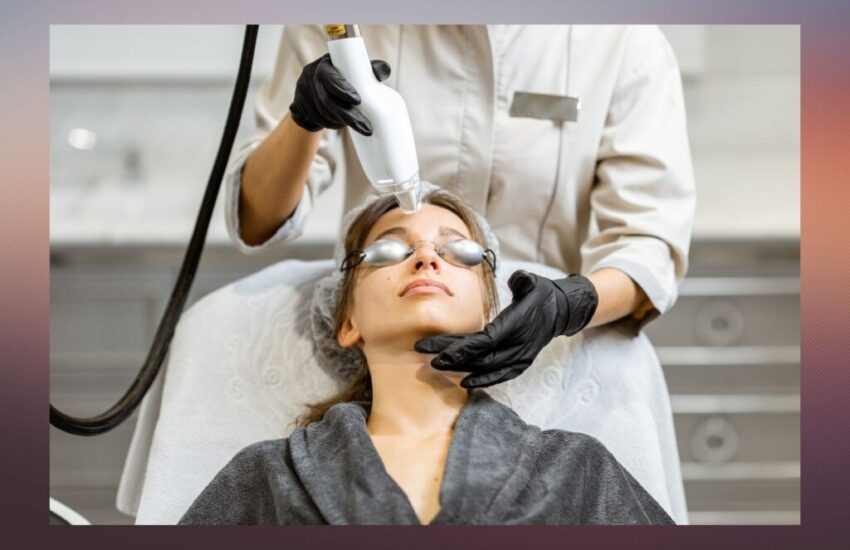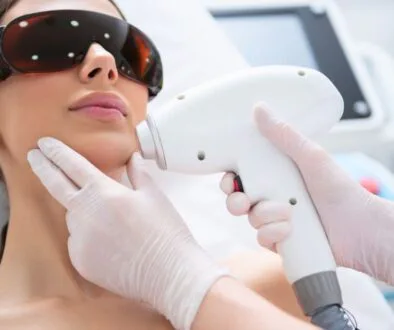Why Picosure Laser Is the Best Melasma Treatment

Published May 9, 2024
If you’re struggling with melasma, one great treatment for it is PicoSure laser. It is the latest trend in the laser technology that is beloved for treating dark spots swiftly and effectively.
In this article, we’re going to unravel all there is to know about it. We’ll discuss its benefits, treatment procedure, and safety. We’ll also have a dedicated section for tips on managing melasma for the best skin possible, post treatment. Let’s start.
What Is a Picosure Laser?
PicoSure laser is a cutting-edge aesthetic treatment technology that significantly advances laser medicine. It is famous for using picosecond (trillionth of a second) laser pulses, making it one of the fastest and most effective laser procedures available.
Unlike traditional lasers, which rely mainly on heat to elicit changes in the skin, this type leverages ultra-short pulse bursts of energy to target the skin’s problematic areas with minimal thermal damage to surrounding tissues.
Why Picosure Is the Best Melasma Treatment?
PicoSure uses pulsed laser energy.
The PicoSure laser is an ultra-targeted type of laser. It makes short pulses of laser energy that go directly to the pigment of your melasma. It breaks it apart so your body can naturally dispose of it.
Other interventions for melasma can sometimes induce discoloration or different effects on the surrounding skin. Yet, this treatment primarily targets the pigmentation in the melasma skin patch. It enhances the look of your problem areas while guarding the surrounding complexion.
PicoSure treatment also results in skin rejuvenation.
Melasma is undoubtedly the cover of a PicoSure laser. What’s more, it can also improve your skin’s tone, elasticity, and texture. The laser smoothes and better the overall appearance of your skin. It evens wrinkles, sun spots, and acne scars. It ensures that once the melasma pigmentation is treated, your underlying skin shines through beautifully.
The treatments are short and relatively painless.
Conventional treatments for melasma may have been long-term. You have to do many things and wait to see results. With PicoSure laser, treatments are short, and you’ll see outcomes quickly. The laser session itself goes for about 30 minutes and is painless. Depending on your specific skin dilemma, you may see improvement in only one session or a little more than that to unlock your desired appearance.
Is Picosure Laser Safe?
Using a PicoSure laser for melasma is safe and painless. The primary irritant in most laser treatments is prolonged exposure to heat, which the PicoSure laser system reduces.
Picosure for Melasma: What’s the Treatment Like?
1. Consultation
Before undergoing the PicoSure treatment, patients usually consult with a dermatologist or skin care adviser to assess their skin conditions. Here, the expected outcomes, potential risks, and number of sessions required are discussed.
2. Preparation
Patients might be urged to avoid sun exposure. Moreover, abstain from specific skin treatments before the session to minimize sensitivity and maximize effectiveness.
3. Treatment session
During the treatment, the Picosure device is applied to the affected area. Patients may feel a sensation similar to snapping a rubber band against the skin. Yet, discomfort is generally minimal. A numbing cream can be used if needed.
4. Duration
Each session typically lasts about 20-3 minutes, depending on the size of the area being treated. The number of sessions needed can vary. It will anchor on your unique skin condition and how it responds to the treatment.
5. Aftercare
Post-treatment, you may experience little redness and swelling. Both will subside within a few hours to a couple of days. It’s critical to follow aftercare instructions carefully.
6. Results
PicoSure effectively reduces the appearance of melasma by breaking the pigment causing discoloration. Yet, melasma can be a recurring condition. It’s Best To invest in additional sessions or maintenance treatments to manage long-term outcomes.
Tips on Managing Melasma
1. Sun protection
Sun exposure can significantly worsen melasma, so diligent sunscreen use is essential. Also, wear wide-brimmed hats and seek shade during peak sun hours.
2. Topical treatments
Over-the-counter and prescription creams contain hydroquinone, kojic acid, azelaic acid, niacinamide, and vitamin C. All combat and lighten dark spots.
3. Chemical peels and microdermabrasion
Professional treatments such as chemical peels and microdermabrasion can help improve the appearance of melasma. They remove the top layers of skin, permitting a new, less pigmented complexion to surface.
4. Oral medications
Oral medications such as tranexamic acid have shown effectiveness in treating melasma, especially for those who haven’t responded well to topical treatments.
5. Cosmetic camouflage
Makeup can be an effective means to conceal hyperpigmentation. It also boosts appearance and self-confidence as you undergo treatment.
6. Lifestyle adjustments
Stress and hormonal imbalances can trigger or worsen melasma. It’s best to practice stress reduction techniques such as meditation, yoga, and regular exercise. If you suspect hormonal factors are contributing to your melasma, it’s vital to discuss this with your healthcare provider.
7. Internal health
Focus on a healthy diet rich in antioxidants and vitamins that promote skin health. Foods high in vitamins C, E, and A and antioxidants can support skin healing and reduce inflammation.
Remember, managing melasma is often about consistency and patience in following through with your skincare regimen and professional treatments. Progress can be gradual, so it’s essential to maintain a routine and monitor your skin’s response over time.

Frequently Asked Questions About Picosure for Melasma.
How many Pico sessions for melasma?
For general pigmentation concerns, including melasma, 2-5 sessions yield the best results.
How effective is a Picosure laser for melasma?
Picosure is effective at breaking down melanin deposits in the skin. These are responsible for the dark spots characteristic of melasma. Moreover, it relies more on photomechanical impact with less thermal damage. The latter is particularly critical for melasma treatments, as excessive heat can exacerbate the condition.
Does melasma come back after Picosure?
Melasma can come back after PicoSure treatment or any laser treatment. Melasma is known for its chronic and recurrent nature. It is a challenging condition to manage permanently. Its recurrent can be influenced by:
- Sun exposure
- Hormonal changes
- Genetic factors
- Environmental and lifestyle factors
Can I do a Pico laser every two weeks?
The frequency of Pico laser treatments, including for conditions like melasma, varies. Generally, Pico laser sessions are spaced out to allow the complexion time to heal and respond to the treatment. It’s more common to be spaced 3 to 4 weeks apart for pigmentation issues and 4 to 6 weeks apart for collagen rebuilding and skin texture improvement.
And now, melasma has got nothing on you. We’ve learned how PicoSure is impressive in managing this skin dilemma. It’s a worthy investment for your skin and in boosting your confidence.
We Are A Medical Beauty Spa In Boca Raton Florida
Four Seasons Laser Center is a highly renowned med spa in Boca Raton Florida. Our state of the art equipment is run by highly trained and experienced staff so you can rest assured that you are in good hands. We offer laser hair removal services for your whole body, PDO Threads facelift, safe and effective Plasma Fibroblast skin tightening, and other advanced medical beauty services to help you look your best. Contact us now to book a free consultation.

Fact Checked By Experts
This content has been thoroughly fact-checked by our team of internal experts. For further information regarding the editorial standards we adhere to, please click here.

About The Author
I am Tracy Gorman, a skilled writer passionate about creating engaging content. With expertise in various topics like lifestyle, beauty, and health, I can craft valuable articles that provide immense assistance.


